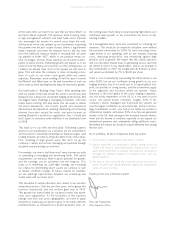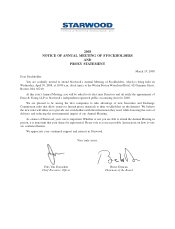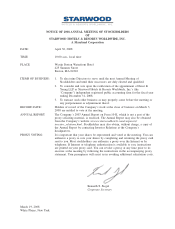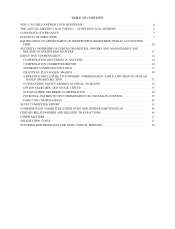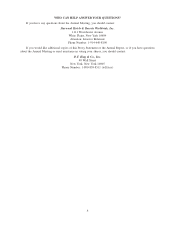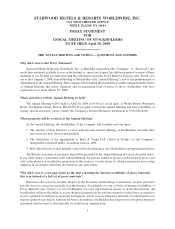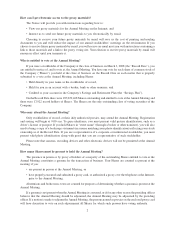Starwood 2007 Annual Report Download - page 4
Download and view the complete annual report
Please find page 4 of the 2007 Starwood annual report below. You can navigate through the pages in the report by either clicking on the pages listed below, or by using the keyword search tool below to find specific information within the annual report.
At the same time, we need to be sure that we ‘Grow Smart’ as
we invest ahead of growth. The expenses we’re incurring today
to sign management contracts and build hotels won’t translate
into meaningful fee income for several years down the road.
And because we’ve only ramped up our investments in growing
the pipeline over the past couple of years, there’s a lag between
today’s expenses and when fee revenues kick in. We also now
have the additional expense related to ensuring that we open
our pipeline of hotels ‘HOT’, which in our parlance means on-
time, on-budget, and full. These expenses are incurred in antici-
pation of future income. Delivering growth will require us to be
smart at how we deploy our resources over the coming years, as
I believe we already have most of the people we will need to
grow. This will allow the company to enjoy increasing econo-
mies of scale as our room count grows while we control
expenses. Remember, we’re working off half the base of rooms
that Marriott and Hilton have, so the best economies of scale are
yet to come as we’re investing heavily today for tomorrow’s growth.
Our fourth pillar is ‘Building Great Teams’. After spending time
with our people in the field around the world, I can tell you that
Starwood has a deep pool of talented lodging professionals. But
our biggest future challenge is managing our growth—100 new
hotels means forming 100 new teams that are ready to deliver
the brand experiences. Our brands, growth and operational
effectiveness will depend on retaining, developing and attracting
talented Associates around the world, and we’re focused on
making Starwood a world-class organization. Also, I should add
that I expect to announce some additions to our leadership team
in 2008.
This leads us to our fifth and final pillar: ‘Delivering superior
returns to our shareholders’. As a baseline, we are committed to
and focused on consistently exceeding our financial targets. And
looking forward, we need to bring discipline to two more areas:
First, investing in high growth areas that don’t tie up the
company’s capital, and second, managing our expenses through
discipline and prioritizing our activities.
For example, our view is that there aren’t many businesses quite
as compelling as managing and franchising hotels. The capital
requirements are minimal, there is great potential for growth,
and the earnings can be sustained over the long-run. This
leads us to redefining our asset-right strategy and reviewing
our criteria for determining which assets we continue to own
as market conditions change. In today’s market, for example,
we see arbitrage opportunities between our underlying real
estate value and our share price.
This discipline in capital allocation also relates to our vacation
ownership business. Over the past few years, we’ve grown this
business dramatically and had another great year in 2007.
This growth has been fueled by our great brands and world-
class sales organization. As the economics of this business
change over time and across geographies, we need to apply
discipline to balancing our desire to grow in the future with the
potential returns, as measured on a project-by-project basis. In
the coming years, that’s likely to mean favoring high returns over
continued rapid growth as we concentrate our focus on key
existing markets.
As a management team, we’re also committed to controlling our
expenses. This would be an important discipline, even without
the economic uncertainty for 2008. So we’re launching a thor-
ough review of our spending, with an eye towards reducing
costs, improving productivity, and reinvesting against high
priorities such as growth. We expect that this capital allocation
and cost discipline should result in generating excess cash that
we intend to return to our shareholders. And as an example of
this commitment, in 2007 we bought back $1.8 billion of stock
and raised our dividend by 7% to $0.90 per share.
There is a lot of uncertainty surrounding the US economy as we
enter 2008, but we see continued strong growth in our core
lodging business due in no small part to our great global foot-
print, our portfolio of strong brands, and the constrained supply
in the segments and locations where we operate. Today,
Starwood is the most global of the major lodging companies,
and not nearly dependent on the US as it has been in prior
cycles. US owned hotels contribute roughly 20% of the
company’s profits. Managed and franchised fee streams are
now the largest contributors to our bottom line, and also increas-
ingly international. In fact, over half of our hotels are located in
international markets, and almost 55% of our fees are generated
outside of the US. And we expect this evolution towards interna-
tional and fee income to continue, especially as we expand our
international presence and contemplate selling additional assets.
We believe this means we should be valued differently than during
the last cycle.
So in summary, I’d like to emphasize three key points:
1) Our business fundamentals were terrific in 2007.
2) We’re committed to continuing to deliver strong results in
2008 and beyond. And importantly, Starwood has never
been better positioned to weather US economic uncertainty,
through our reduced reliance on owned hotels, and our
global footprint.
3) We have a clear vision for the company’s future that can be
easily tracked and should generate significant shareholder
value for years to come.
Thank you for your continued support.
Frits van Paasschen
Chief Executive Officer
Starwood Hotels & Resorts Worldwide, Inc.




